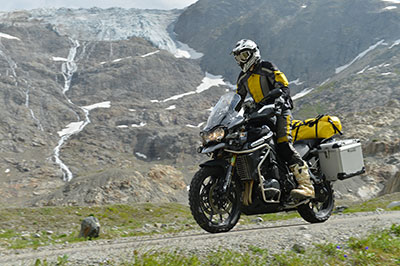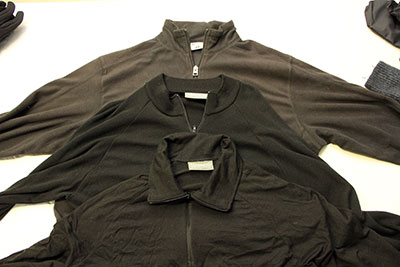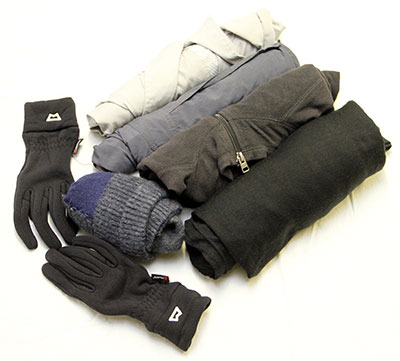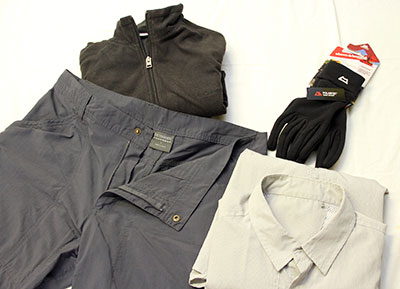Preparing & planning for adventure – Part 2: Clothing
Your bike’s fully prepped, you have your route all mapped out and you’re ready to go. But what are you going to wear, and just as important, will you fit all your gear on the bike?
With all the other preparation that goes into an adventure ride, it’s easy to forget the most important aspect – you! If you’re not warm, dry and comfortable on your ride, then the enjoyment factor just won’t be there.
Swiss-AlpsOur experiences over a lifetime of riding have taught us plenty of tricks, so here are a few of them to help you on your way.
For a start, the clothes you pack need to be used in all situations – both on and off the bike. In every case possible the clothes should be used as extra layers when you’re riding the bike, and be comfortable and practical when not riding.
Let’s cover your ‘off the bike’ attire first.
OFF THE BIKE
PANTS
Your pants need to be lightweight and made from quick-dry materials, ideally, with a cotton content of up to 70 per cent, and 30 per cent nylon. You can also get this combination in pants that zip apart and become shorts. These also look quite smart and importantly, pack light and dry quickly.
Lightweight material is not quite as good as denim in the cold, but it’s very close. Denim is no good when it’s wet, or when it’s hot, and is only ever carried if you like the look and feel of it when you’re off the bike, but it’s a luxury.
Along with our own use, this is also what Mick McDonald from Compass Expeditions uses and recommends to his travellers to cover both hot and cold travel, whether that be in Russia, South America or in Australia.


TOPS / JUMPERS
Thermal-layers
Your base layer, mid-layer and micro-fleece should be made from merino wool, and provide warmth, whether you are on or off the bike.
Any of the lightweight materials are recommended, and a 70 per cent cotton content does improve the comfort. Any sort of comfortable shirt is fine for adventure travelling, but a micro-fleece jumper, as opposed to polar fleece, is always a better way to go, packing a lot smaller.
Polar fleece jumpers will not stop wind. They are very warm, but they have no wind stopping capabilities, whereas micro-fleece will give you nearly the same warmth, plus keep the wind out.
For the extreme cold – such as on the Road Of Bones – a fully waterproof outer shell is an absolute must to carry. They pack very light, stop the wind at the outside and totally remove the chill factor.
Make sure you wear any shirt beforehand in both hot and cold conditions, to ensure it doesn’t get sweaty or clammy. All shirts work well in ideal conditions, but do your own research before setting off on a trip.
SOCKS
COOLMAX is the material that most of the good adventure socks are made of. This works well for many people, but we’ve found they don’t have very good warmth capabilities, but provide good comfort and moisture wicking. COOLMAX tends to stop the sweating between your toes, so if you suffer from sweaty feet, they are a good option.
My own preference is the merino-possum fur combination that would typically be a hiking sock. They don’t need to be super long, but about halfway up your calf. This combination will keep you warm, breathes very well and doesn’t smell, so copes with multiple use very well. I even wear these when riding in central Australia as I find they keep my feet more comfortable, and stop them from getting clammy, sweating and then cold.
Around the world traveller, Sherri Jo Wilkins, used the COOLMAX socks on her three-year trip and was very happy with them, and when it got colder she just added another pair of socks. It’s all a personal choice, but if you have no experience whatsoever, you won’t go wrong using the merino-possum fur combination, both for comfort, and to cover warmth.
The other option on the bike are waterproof socks. When it’s cold and wet they work quite well, but they get clammy very easily, and as soon as it warms up they have no breathability whatsoever, and you end up wet on the inside just from your own feet sweating. They do have a place, but it’s in a very small band of riding that they’re ideal.
THERMALS
Folded-clothes
Shirt, long pants, mid-layer therma, mirco-fleece jumper and sock rolled up and ready to pack.
Thermals are a must both on and off the bike, and it’s pretty much unanimous among the experts that merino thermals work a little better than the rest. They don’t smell, they pack small and they perform better across the board.
Wool used to be always too itchy and prickly to wear against your skin, but the Australian Wool Board put a lot of research into making wool more friendly and easy to wash and wear, and once you get under 17 micron (one fifth of the diameter of the average human hair) the itchiness and prickliness disappears. But you need to ensure your thermal is made from superfine merino wool. The absence of a smell after multiple uses is a big advantage as well.
Merino thermals are widely available from most outdoor shops, dealing in hiking and outdoor adventure.
As an alternative, woollen tights also provide good warmth and are used by many riders. Being worn underneath your other gear, men can get away with wearing them as well.
FOOTWEAR
Sherri Jo Wilkins and Compass Expeditions all carry a pair of thongs (or flip flops) on their travels, for general shower situations and getting around the camp.
You will also need a pair of hard soled footwear of some sort, as prickles such as bindii will go through thongs. Hard soled shoes can look good and are useful both at your destination, and as a welcome relief from your riding books.
BITS AND BOBS
Don’t forget that a hat and sunscreen are essential items on and off the bike and are often overlooked. If you are travelling in colder climates and at altitude, you tend to forget that the sun can be a factor. As it gets colder the humidity drops and in the higher altitudes sunburn can happen very fast and be very damaging. Don’t get caught out.


ON THE BIKE
RIDING SUITS
To start with, the outer layer of your riding suit must be completely waterproof, whether it be a part of the suit or an additional layer. If it’s part of the suit it needs to have a laminated Gortex outer (such as the Touratech Companero suit), as the plastic layer part way through is usually not 100 per cent waterproof.
The downside of using an external waterproof layer is that they get very hot and sweaty as soon as they get warm inside. This can be very uncomfortable, and you’ll find you’re forever putting your waterproofs on and off.
However you do it, you must have full waterproofing on the outside.
LAYERS
Underneath your suit, on the top part of your body, you can have a simple polo shirt or any sort of comfortable shirt, but when it gets colder you need to layer up with merino thermals.
The merino mid-layer material is very common in any cold climates, including on the ski fields, and works very well. They also look dressy off the bike too. We’ve tested this theory on the Canadian ski-fields at temperatures of minus 16 degrees C, so we can vouch for our recommendation.
From the outside, you’ll need your riding suit (and waterproof), a micro-fleece jumper, a merino mid-layer thermal, your normal shirt, and a merino thermal base layer. This combination will cope with extreme cold, and they pack really small.
Outer-wear
Choosing clothing to wear both on and off the bike will save valuable packing space.
On the bottom half of your body, start off with your riding suit (and waterproof), thermals, and your underwear of choice.
BOOTS
Ideally you need waterproof boots otherwise you’ll get wet feet and then you’ve got problems.
On long hauls, Forma boots, or this style of boot – which are somewhat of a motorcross boot, but with very good walking comfort – are fully waterproof and have nice leather on the outside.
You need to be comfortable, so test them out in a range of situations before you set off on your big trip. Nobody likes sore feet!
HEADWEAR
A scarf or balaclava is great for extra warmth and to get a full wind break around your neck. You’ll never get a cold head wearing a helmet, but you can get a cold face, which can be extremely uncomfortable.
A silk scarf or a very lightweight balaclava that can cover your nose and face will do the trick, especially if you are using a motorcross style helmet.
While a kidney belt is intended to support your back, they do a great job of keeping your back warm, although they can be hot in the warmer climates. Sherri Jo Wilkins used a kidney belt on her trip, simply as a means for extra warmth, so it’s not an uncommon practice.


GLOVES
My preference is not to go to a heavy type of winter glove, but to use a summer glove that is lighter, with silk gloves inside.
On a bike fitted with hand guards that provide good wind protection, at between 8 and 11 degrees, your hands start to feel a bit cool, and at 7 degrees they are progressively feeling more and more uncomfortable. Just by adding a silk inner glove you will go back to quite a warm feeling.
Silk is a fantastic fibre that is light, offers good thermal qualities, keeps the warmth in really well, and is still comfortable against your skin when it warms up. This thought is consistent among adventure riders.
Over the top of my gloves I wear a fully waterproof outer mitten. They are a bit bulky, but if you suffer from cold hands at all it is the answer. They break the wind and keep your gloves dry. They do reduce the feel, but the negatives from that are offset by what happens if your fingers get too cold and numb – you’re actually riding dangerously at that point.
Mittens hold the heat in better as they haven’t got the surface area for the chill factor to get to. I always carry pair of them in my kit, and get them from Andy Strapz.
UNDERWEAR
Men typically get by with a couple of sets of underwear, even on extended trips. Lady adventurers have been known to carry four sets because sometimes it’s hard to find the opportunity to wash them regularly.
PACKING
And finally, rolling your clothes to pack them uses a lot less space. You can apply more pressure to the clothes, they will still look okay when you unpack them, but the space saving advantages is well worth it.
This may take a little practice, but you’ll soon find that by rolling your clothes you can pack them in all the nooks and crannies of your luggage, ensuring that you have room for other items you may wish to take.
WHERE TO BUY
As a rule we don’t stick to any one manufacturer, and have had great results with a number of different products and brands over the years.
The specialised adventure camping stores will stock brands such as Jeep, Kathmandu, Ice Breaker, Merinos and Columbia, while some of the specialised motorbike retailers will also stock clothing for your big adventure.


